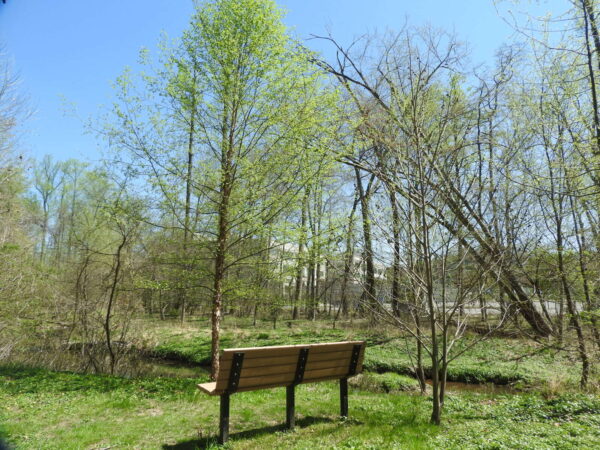
Vienna’s tree canopy may be shrinking, but the trees still standing are actually doing quite well, a recently released town-wide inventory found.
About 88% of the 7,224 trees on public land examined by PlanIT Geo are in “fair” or “good” condition, the consultant told the Vienna Town Council when presenting its findings on June 20.
“I’ve looked at a lot of data across a lot of projects, and I don’t think I’ve seen one as good of health as Vienna’s trees are in,” PlanIT Geo Director of Field Operations TJ Wood said, decreeing the town’s tree population to be in “very good health” overall.
That does still leave roughly 722 trees that were found to be in poor condition or dead, according to the inventory, which was initiated based on a recommendation by an urban tree canopy assessment that the town received last October.
Focused on trees on public property, including any within the street right-of-way and parks, the inventory identified tulip poplars as the species with the highest mortality rate at 12 dead trees. The species with the biggest showing in the “poor” category was red maple, which isn’t surprising when it constitutes 16.6% of the total inventory, Wood said.
He reported that, while Vienna has “a very diverse urban forest overall” with 162 unique species, the top 10 most common species make up almost 51% of the population, led by the 1,200 red maples recorded by PlanIT Geo.
“There’s a lot of room to diversify tree plantings and try new species out,” Wood said.
In another sign that Vienna could use some more trees, less than 30% of its trees have a diameter of 1 to 6 inches, suggesting the town is “lacking in new plantings.” Wood added that the town could get close to the ideal rate of 40% if it puts a tree in all 1,222 sites that the inventory identified as suitable for plantings.
Despite the overall healthiness of Vienna’s urban forest, the inventory says 3,968 trees, or 65% are in need of some maintenance. The majority are recommended for some kind of pruning to remove dead wood and hanging limbs or prevent them from growing into utility lines, signs and other infrastructure.
However, 290 trees were deemed to be at moderate risk, meaning they should be revisited at least once a year, and there are 25 high-risk trees.
“I would recommend anyone visit immediately and get another set of eyes on them, decide whether those need to be removed, or if there is a mitigating factor that can be done to reduce that risk to public safety,” Wood said, pointing to a red maple with a split trunk that could fall on a street or sidewalk as an example of a high-risk tree.
Vienna Park Maintenance Superintendent Jeremy Edwards noted that there are still some trees in parks, including Northside and Wildwood, that haven’t been examined and added to the inventory yet. The survey didn’t include trees on private property and along the Washington & Old Dominion Trail, which isn’t town-owned.
All of the data collected is now publicly available through a TreePlotter database that town staff will be able to update in real time.
Last year’s tree canopy assessment found that the town’s canopy has declined by 163 acres, or 13%, since 2011. In January, the town council designated improving the canopy as a top priority for 2023, and Vienna is currently considering an ordinance that would require developers to preserve trees, instead of just replacing ones they cut down.
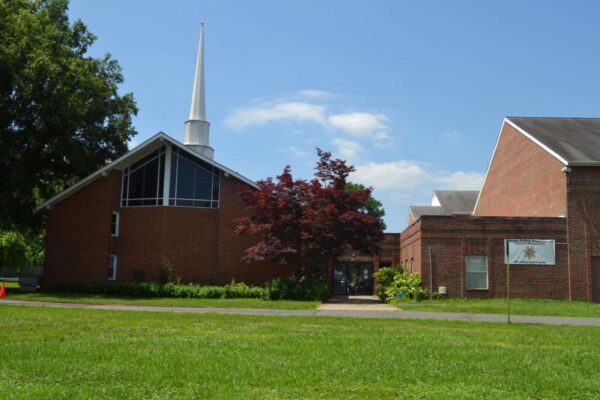
The Vienna Town Council appears inclined to raze the former Faith Baptist Church, as a study continues to sift through ideas for the long-term future of the site now known as the Annex.
A vote on whether to demolish the now-vacant building at 301 Center Street South has been set for June 5. While no decision was made, a majority of council members indicated at a conference session Monday (May 8) that they would rather knock down the structure than invest money in maintaining it.
Council members Howard Springsteen and Ed Somers seemed open to keeping the church gymnasium — another option suggested by the consultants conducting the study — but it was unclear how much that would cost compared to replacing the 1950s-era building with new, temporary recreational facilities.
Martin Kimmel, president of the consulting firm Kimmel Bogrette Architecture + Site, confirmed the team could provide “rough” cost estimates in time for the June vote.
“It’s going to come down to cost,” Councilmember Steve Potter said. “I’m leaning toward don’t put good money into bad. I think the best thing would be to demolish the building, but I’m having a hard time making a decision because we don’t have all the information.”
It will cost about $250,000 to fully demolish the church and remove the resulting debris, town staff estimated.
The town purchased the former church on Aug. 31, 2020, turning it into a temporary base for the Vienna Police Department until its new headquarters was built. The move-in process was completed in January.
After a review found that it would take $500,000 just to bring the existing building up to code, the council commissioned Kimmel Bogrette and fellow consultant Kimley Horn to help the town develop a long-term vision before it makes any short-term commitments.
Based on initial public input, including a still-open online survey and an in-person workshop, community members would love to see recreational amenities of some kind — particularly an indoor pool or other aquatics facility — in the Annex’s future.
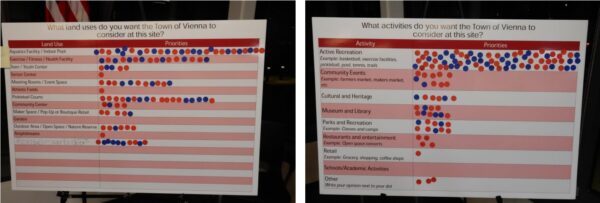
“There was no doubt the word ‘pool’ jumped out” as a use that should be evaluated, Somers said, referencing a word cloud in the consultant team’s presentation.
An exercise or fitness facility, pickleball courts and meeting space also got solid support as potential uses at the March 28 workshop, which was held in the new police station.
With the police station costing about $14.1 million, it will likely be at least a decade before the town can implement another project of that magnitude. That may not be as far off as it seems, given the amount of time needed for planning, design and construction, Town Manager Mercury Payton noted.
Springsteen said a pool seems “cost-prohibitive” when the town already has millions of dollars worth of capital projects to address, from road improvements to sewer upgrades. Other council members suggested all options should remain open until they get a clearer idea of the costs.
Kimmel Bogrette proposed bringing in another consultant that could conduct a market and operational analysis. For an additional $23,500, the analysis would evaluate different possible uses for the site and project potential demand, construction and operational costs, and revenue.
Some council members expressed skepticism at the need for that analysis, though Payton said the consultant would be able to provide a more detailed, informed review than what town staff could manage. The proposal will come up for a vote on June 5.
“I don’t know what we’d wait for. We have to know what the costs are,” Mayor Linda Colbert said.
In the meantime, Kimmel’s study will proceed with more community engagement events at the Vienna Community Center from 4-7 p.m. today (Wednesday) and from 10 a.m.-2 p.m. on Saturday (May 13).
A final recommendation is scheduled to be presented to the council on June 12.

(Updated at 3:55 p.m.) The Fairfax County Police Department and George Mason University have joined forces with an Arlington-based think tank to study how the attitudes and behavior of police officers evolve over the course of their careers.
Touted as the first of its kind in the U.S., the long-term or longitudinal study is intended to give the FCPD and other police departments a better understanding of how to address staffing challenges by following a select group of officers, potentially over decades.
The results could inform the FCPD’s recruiting efforts and provide a new look at what makes someone a successful police officer, Fairfax County Police Chief Kevin Davis said at a 1 p.m. press conference, noting that divorce, suicide, alcoholism and domestic violence rates among police are “higher than the national norm.”
“We’re really happy to engage in this long-term journey to figure out what success looks like for Fairfax County, because we want to continue to lead on behalf of our profession,” Davis said. “We think over time and hopefully over many years, we’ll learn a lot more about who wants to become part of this profession and, once they enter our ranks, what determines their trajectory for success.”
Looking at both applicants and current officers, the study will be conducted independently by Dr. Cynthia Lum, a criminology professor in GMU’s Center for Evidence-Based Crime Policy, and the National Policing Institute.
With a gift provided by philanthropist MacKenzie Scott in 2022, the institute is funding the estimated $300,000 cost of the study’s first three years. That includes $186,401 that went to GMU to support its costs, according to National Policing Institute President Jim Burch.
Researchers hope to get enough money from public and private funders to continue the study for 10 to 20 years, Lum said.
With a current vacancy rate of 206 positions, the FCPD has been operating under a personnel emergency since July 2022, meaning officers are required to work overtime with two shifts in rotation instead of the usual three.
Compensation has emerged as the top concern from interviews with officers, though it’s not the only one, according to FCPD Administrative Support Bureau Commander Major Gregory Fried, citing a desire for a better work-life balance as another issue that has come up.
The police department has recently committed more money to job advertising and pay for public safety workers, along with efforts to modernize the hiring process. The next academy class starting April 24 will have 58 graduates, the most in a decade, Davis said.
Still, officer recruitment and retention have become a struggle for law enforcement agencies across the country.
“We’re losing some of our best, and we struggle to bring in the best as well. As we face these challenges, though, taxpayers rightfully expect more,” Burch said. “Communities want more effective and fair policing. They want safer communities…The reality is policing is a profession. It’s not a vocation…We must invest, and that’s what this study is about, investing in those who step up to serve in their communities.”
The national exodus of officers has frequently been attributed to declining morale in the face of heightened public scrutiny, but Covid and mass early retirements may be bigger contributors to burnout, according to The Marshall Project, which reported earlier this year that local government employment in general has dropped since 2020.
Burch hopes to see the study of Fairfax County police officers replicated in other jurisdictions.
“What we learn here in Fairfax County will inform and improve policing across the United States,” Burch said.
The FCPD is also working with the D.C. nonprofit Police Executive Research Forum (PERF) on a review of shootings by its officers, which increased last year. That study was initiated in early March after Maryland resident Timothy Johnson was shot and killed outside Tysons Corner Center on Feb. 22.
Davis announced on March 23 that the officer who fired the fatal shot that evening had been fired.
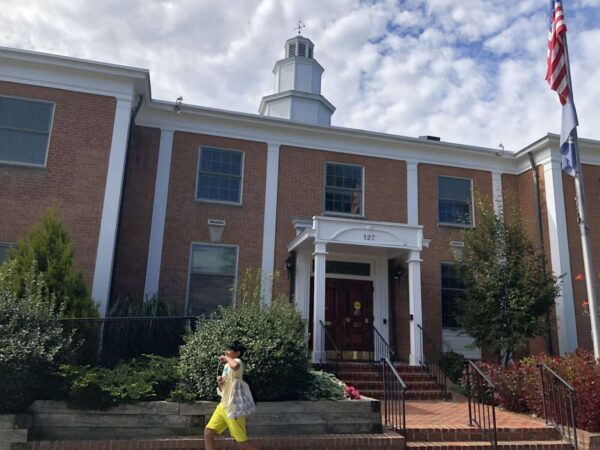
The Town of Vienna wants to give its employees more breathing room — literally.
Some space has been freed up in town hall by the Vienna Police Department’s criminal investigations bureau relocating to its recently completed station. The department’s transition to the new station will be conclude with its communications team moving in by the end of January, according to a spokesperson.
As a result, the town is reorganizing how it uses the town hall building at 127 Center Street South to maximize efficiency and relieve cramped conditions that relegated one worker to a ventilated computer server room, Town Manager Mercury Payton told the Vienna Town Council on Jan. 9.
“[That] probably wasn’t the best thing for his health. We’re going to be moving him out of that area into a vacated space,” Payton said. “So, we’ve already kind of determined internally ourselves some of our best moves, and then we’ve kind of gone as far as we can go.”
To assist with the reconfiguration, the town council approved a $84,900 contract for PMA Architecture to conduct an office space study. The consulting firm was chosen from 10 candidates based on its “innovative yet practical ideas” and experience working with smaller governments, Vienna Finance Director Marion Serfass said.
Built almost 60 years ago, town hall was last renovated in 2014 when it got a new heating, ventilation and air-conditioning system, but there was little consideration of workplace layout at that time — an oversight that became apparent as Covid heightened concerns about the spread of disease.
About 47 employees work out of town hall, not including the 12 recently relocated police personnel, according to a request for proposals issued by the town in August.
While there hasn’t been a huge increase in staff, the services offered by the town have evolved and expanded, Serfass said.
“We’re focusing on economic development, we’re focusing on video content, we’re adding slightly to town hall staff,” she said. “Some of these additions are temporary, but some may become permanent, so town hall staff is sort of bursting at the seams right now.”
The funds for the space study come from Vienna’s American Rescue Plan Act allotment, which can be used to prevent the spread of disease in the workplace. The town previously used federal Covid relief money to install an air filtration system and Plexiglas barriers, among other needs, according to Serfass.
In addition to reviewing room layouts, equipment and storage space, the study will take security needs into account, PMA Architecture Principal Katie Stodghill told the town council.
“I was very pleased to hear you raise the issue of public safety,” Councilmember Ed Somers said. “We live in a different era than we did years ago. We deal with a number of issues where people are frustrated about many things, and their most accessible level of government…is their local government. I do worry often about our staff that are there all the time.”
An exact timeline for the study hasn’t been established yet, but when it’s completed, a final report and the consultant’s recommended solution will be presented to the town council.
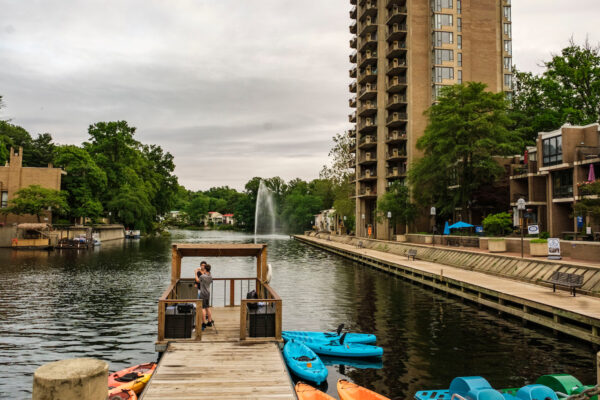
A new vision for the future of the Lake Anne area in Reston is brewing.
Fairfax County has hired the consulting firm Streetsense to lead the visioning effort. Beginning next month, the team will launch an initial immersion and discovery phase, followed by a significant community engagement process, according to Tracy Strunk, director of the Fairfax County Department of Planning and Development.
“A final report will identify a strategic position for the area within the competitive landscape, and guide future developments, including branding, marketing, design, and merchandizing, that create a market-relevant consumer experience,” Strunk said.
The four-month study will cost roughly $125,250.
The report will target the Lake Anne Commercial Revitalization Area in an effort to create a market approach with the interests of area stakeholders. The 44-acre area was established in 1998.
At a meeting with media yesterday (Monday), Hunter Mill District Supervisor Walter Alcorn emphasized that the “economic visioning study” will begin with conversations with “various stakeholders.”
Earlier this year, the county approved $300,000 in county funds to help develop a revitalization plan for the area.
In a Jan. 10 letter to Lake Anne residents, Alcorn said the funding would be used for economic envisioning and master planning in order to “support the long-term sustainable development planning for Lake Anne.”
A cursory review of the plaza flagged nearly $37 million in repairs for the aging area.
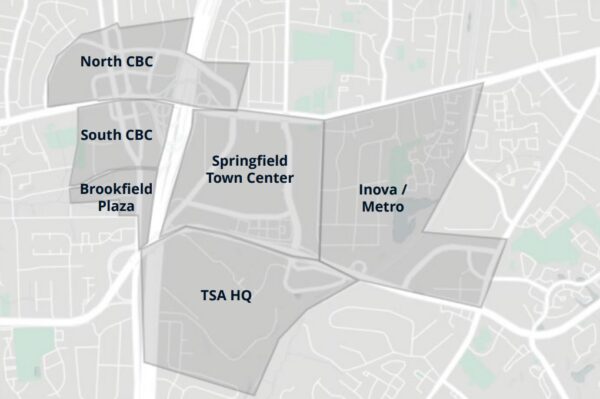
A decade after Springfield Mall was torn down, reemerging two years later as Springfield Town Center, Fairfax County officials are still trying to figure out how to make the reality of the development match that rebranding.
Progress on transforming downtown Springfield from a commercial hub into the more mixed-use, walkable environment envisioned by county planners has been slow, even nonexistent when it comes to housing, a recently released study found.
In fact, the area hasn’t added a single multifamily residential unit since the Springfield Crossing apartments were built in 2001, according to the Springfield-Franconia Market Study commissioned by the Fairfax County Economic Development Authority (FCEDA).
“That’s insane,” Franconia District Supervisor Rodney Lusk said. “Think about it for a second. Every market has had some sort of residential construction. We have had zero. So, that’s something that we have to obviously think about and figure out where we might allow more residential options…in the areas that make up the Franconia-Springfield market.”
Attributed at least in part to lower rents compared to areas like Tysons or Bethesda, the lack of housing isn’t the only challenge facing downtown Franconia-Springfield, which is concentrated around the I-95 and Old Keene Mill/Franconia Road interchange.
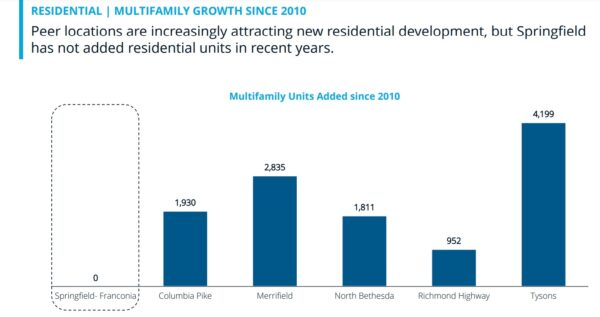
According to the study, which was conducted by the consultant HR&A, Springfield has 3.2 million square feet of retail development, 2.7 million square feet of office space, 978 multifamily units, 1,843 hotel rooms, and 0.3 million square feet of industrial space.
While the existing shopping centers, including the town center, are performing well overall, retail growth has slowed with just 22,000 square feet added since 2010, and vacancies have jumped to 6.4% during the pandemic.
Covid also drove up vacancies in the office market, where the rate climbed from 13% pre-pandemic to 19% as of early 2022, and sent hotel occupancy rates tumbling from 73.7% in 2019 to 28.4% in 2020 before bouncing back to 51% this year.
Aside from industrial construction, which has stalled since 1988, the study projects room for growth across all markets over the next 10 years, including 1,000 to 1,600 multifamily units, but mixed-use development is necessary to achieve that potential.
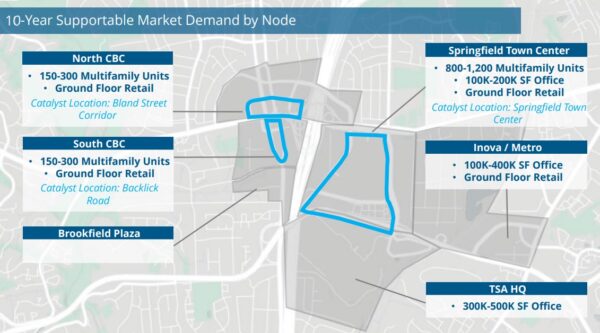
“There have been significant private investments in Springfield, most notably at Springfield Town Center and the TSA headquarters,” the report said. “However, growth has been focused on site-specific investments, not mixed-use development supportive of County goals or catalytic growth.”
Mixed-use development would require not only more housing, particularly mid-rise buildings less than eight stories tall, but also amenities and public infrastructure to draw residents, workers and the tourists that the study says are needed to offset declining business travel. Read More
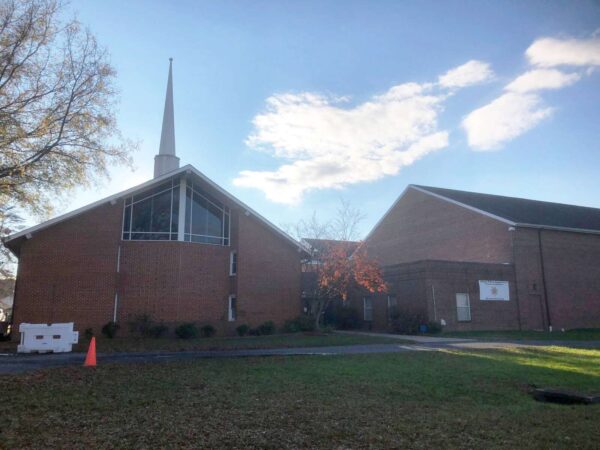
The Town of Vienna is seeking a little guidance to determine what to do with the former Faith Baptist Church property on Center Street.
The town council approved an allocation of $92,500 on Monday (Nov. 14) to launch a study of potential long-term uses for the site, now known as the Vienna Annex.
After receiving two bids in response to its request for proposals, the town has contracted Pennsylvania-based firm Kimmel Bogrette Architecture + Site to conduct the study, whose findings will eventually be presented to the town council.
“The information from the Annex Long-Term Use Study will provide recommended land uses of the annex property based on the town’s strategic plan, [comprehensive] plan, extensive community engagement and available funding in the long run,” Vienna Parks and Recreation Director Leslie Herman said.
The town bought the 3-acre property at 301 Center Street South for $5.5 million in fall 2020, giving the Vienna Police Department a temporary base during the construction of its new headquarters. Though there was a ribbon-cutting ceremony in early September, some final work is still being done before the building can be occupied.
As officers prepare to move out at some point, town leaders have been debating the best long-term use of the former church and have, thus far, come up with a big question mark.
Herman initially proposed utilizing the building temporarily as an annex for recreational activities to supplement the Vienna Community Center, but the town council feared that would cut off other long-term possibilities, particularly since a previous study estimated the conversion would cost $1 million.
The council authorized the removal of a cross from the building’s steeple in September but declined to fund roof repairs, saying it didn’t want to invest in a building that may ultimately be torn down.
When asked by Councilmember Ray Brill, Kimmel Bogrette confirmed that it will consider the possibility of demolishing all existing structures when exploring options for the site.
“Our approach to community engagement is to try to help folks see beyond what they see there today and look at the possibilities,” Kimmel Bogrette president and co-founder Martin Kimmel said.
Town staff will meet with the consultant next week to determine a detailed timeline for the study, according to a Town of Vienna spokesperson.
“Public engagement is expected to take place in January and February, 2023 and a final report is expected to be presented to Town Council in June,” Vienna Public Information Director Karen Thayer told FFXnow.

